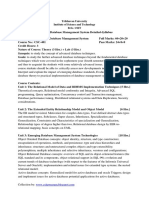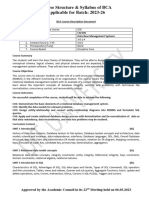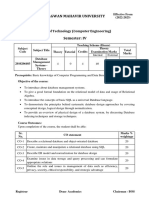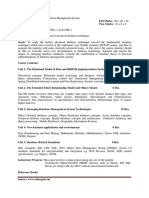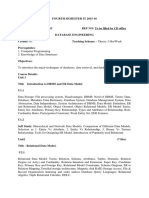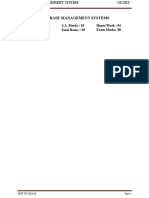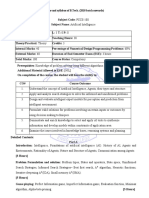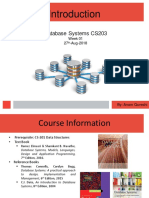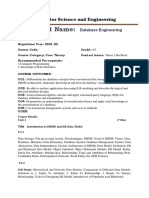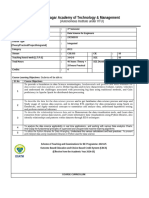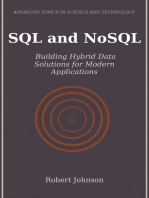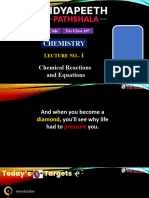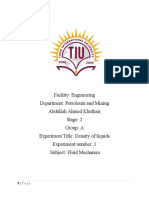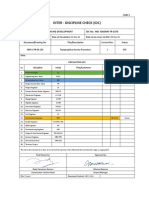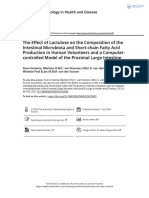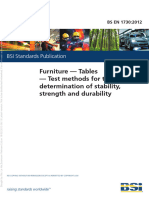ADBMS
ADBMS
Uploaded by
NaranCopyright:
Available Formats
ADBMS
ADBMS
Uploaded by
NaranOriginal Description:
Copyright
Available Formats
Share this document
Did you find this document useful?
Is this content inappropriate?
Copyright:
Available Formats
ADBMS
ADBMS
Uploaded by
NaranCopyright:
Available Formats
Tribhuvan University
Institute of Science and Technology
B.Sc. CSIT
Advanced Database Management System Detailed-Syllabus
Course Title: Advanced Database Management System Full Marks: 60+20+20
Course No.: CSC-401 Pass Marks: 24+8+8
Credit Hours: 3
Nature of Course: Theory (3 Hrs.) + Lab (3 Hrs.)
Synopsis: to study the concept of advanced database techniques.
Goals: to study the further advanced database techniques beyond the fundamental database
techniques which were covered in the sophomore year (fourth semester) BSc. CSIT course,
and thus to acquaint the students with some relatively advanced issues. At the end of the
course students should be able to: critically assess new developments in database technology,
Interpret and explain the impact of emerging database standards, Evaluate the contribution of
database theory to practical implementation of database management systems.
Course Contents:
Unit 1: The Relational Model of Data and RDBMS Implementation Techniques [5 Hrs.]
Theoretical concepts, Relational model conformity and Integrity, Advanced SQL
programming, Query optimization, Concurrency control and Transaction management,
Database performance tuning, Distributed relational systems and Data Replication, Security
considerations.
Unit 2: The Extended Entity Relationship Model and Object Model [6 Hrs.]
The ER model revisited, Motivation for complex data types, User defined abstract data types
and structured types, Subclasses, Super classes, Inheritance, Specialization and
Generalization, Constraints and Characteristics of specialization and Generalization,
Relationship types of degree higher than two, Relational database design by EER-to-
relational mapping, basic concepts on UML.
Unit 3: Emerging Database Management System Technologies [18 Hrs.]
Object Oriented Database concepts: object identity, structure, and type constructors;
encapsulation of operations, methods, and persistence; type and class hierarchies and
inheritance; structures and unstructured complex objects and type extensibility;
polymorphism, multiple inheritance and selective inheritance, versions and configurations;
Object Relational Database concepts: overview of SQL and its object-relational features (the
SQL standard and its components, object-relational support in SQL-99); evolution and
current trends of database technology (with respect to the features of the Informix Universal
Server and Oracle8); implementation and related issues for extended type systems; the nested
relational model;
Active database concepts: Generalized model for active databases and oracle Triggers; design
and implement issues for active databases potential applications for active databases;
Collection by: www.csitprogram.blogspot.com
Temporal database concepts: Time representation, calendars, and time dimensions;
incorporating time in relational databases using tuple versioning, incorporating time in
object-oriented databases using attribute versioning, time series data;
Multimedia Databases: The nature of multimedia data and applications; spatial database
concepts and architecture, introduction to multimedia database concepts;
Deductive databases and Query processing: Prolog/Datalog notations, clausal form and horn
clauses; interpretations of rules;
Mobile Databases: Mobile computing architecture, characteristics of mobile environments,
data management issues; Geographic Information Systems: GIS applications, data
management requirements of GIS, specific GIS data operations;
Unit 4: New database applications and environments [8 Hrs.]
Data Mining: Overview of data mining technology (associated rules, classification,
clustering), applications of data mining; Data Warehousing: Overview of data warehousing,
typical functionality of a data warehouse;
Unit 5: Database Related Standards [8 Hrs.]
SQL standards, SQL 1999, SQL 2003, Object Data Management Group (ODMG) version 3.0
standards (ODL, OQL), Standards for interoperability and integration e.g. Web Services,
SOAP, XML related specifications, e.g. XML Documents, DTD, XML Schema, X-Query, X-
Path.
Laboratory Projects:
The course involves a mini project using any one of the popular Commercial Object-Oriented
DBMS software such as Oracle, MS SQL Server etc., along with any MVC software
development framework.
Prerequisite:
Be familiar with at least one OO Programming language such as .Net or C++ or Java,
Fundamentals of DBMS, SQL
Reference Books:
1. Elmasri and Navathe, Fundamentals of Database Systems, Pearson Education
2. Raghu Ramakrishnan, Johannes Gehrke, Database Management Systems, McGraw-Hill
3. Korth, Silberchatz, Sudarshan, Database Systems, Design, Implementation and
Management, Thomson Learning
4. C.J. Date & Longman, Introduction to Database Systems, Pearson Education
Computer Usage:
Windows or Linux based PC or workstation, Commercial OODBMS software package and
MVC software development framework installed at the server.
Category Content: Science Aspects: 60%
Design Aspects: 40%
Collection by: www.csitprogram.blogspot.com
Model Question (Advanced Database Management System)
Tribhuvan University
Institute of Science and Technology
Bachelor Level/Fourth Year/Seventh Semester/Computer Science and IT
Advanced Database Management System (CSC-401) (Sample Question Paper)
Full Marks: 60 Pass Marks: 24 Duration: 3 Hrs.
Attempt all Questions.
1. Explain the following terms:
a. Spatial database
b. ECA model
c. Federated DBMS
d. Well-formed and valid XML document
e. GIS
f. Classification and clustering
2. How does a category differ from a regular shared subclass? What is a category used for?
Illustrate your answer with suitable examples.
OR
Describe the steps of the algorithm for object database design by EER-to-OO mapping.
3. What is the difference between persistent and transient objects? How persistence is
handled in typical OO database systems?
4. Describe different implementation issues with object relational database system.
5. Discuss the different technique for executing an equijoin of two files located at different
sites. What main factors affect the cost of data transfer?
OR
What are the main difference between designing a relational database and an object
database?
6. Differentiate between attributes and elements in XML? List some of the important
attributes used in specifying elements in XML schema.
OR
What is the difference between structured and unstructured complex object? Differentiate
identical versus equal objects with examples.
7. Explain mobile computing architecture with suitable diagram.
8. What are the difference and similarities between objects and literals in the ODMG Object
Model?
9. What is a data warehouse? How does it differ from a database?
OR
Describe multimedia database and what are the different types of multimedia data that are
available in current systems?
10. Describe the main reasons for and potential advantages for distributed database. What
additional functions does it have over centralized DBMS?
Collection by: www.csitprogram.blogspot.com
You might also like
- Advanced Database Management System (CSC-401) (Sample Question Paper)Document1 pageAdvanced Database Management System (CSC-401) (Sample Question Paper)Bibash AdhikariNo ratings yet
- Advanced Database Management SystemsDocument1 pageAdvanced Database Management Systemssakeynii100% (1)
- Algorithms and Data StructuresDocument37 pagesAlgorithms and Data StructuresjimmyNo ratings yet
- Lecture Notes On Atomic and Molecular Physics: With Solved Examples and HomeworksDocument2 pagesLecture Notes On Atomic and Molecular Physics: With Solved Examples and HomeworksVivek KumarNo ratings yet
- Adbms Lectures Midterm-ADBMSDocument3 pagesAdbms Lectures Midterm-ADBMSNikinChitrakarNo ratings yet
- 4 Bca 4th Sem Syllabus UemjDocument12 pages4 Bca 4th Sem Syllabus Uemjapi-351162654No ratings yet
- DBMS Theory-B.Tech CSEDocument2 pagesDBMS Theory-B.Tech CSE20btcse23No ratings yet
- Syllabus CAF106 (DBMS)Document2 pagesSyllabus CAF106 (DBMS)udit rawatNo ratings yet
- DATA MANAGEMENT II Lecture IDocument18 pagesDATA MANAGEMENT II Lecture Iumarsbaba2002No ratings yet
- CSC2203 Database Systems: Course Information SheetDocument3 pagesCSC2203 Database Systems: Course Information SheetFaisal Rehman KhanNo ratings yet
- CS3492 DBMS Univ - QP Answer AM 2024Document19 pagesCS3492 DBMS Univ - QP Answer AM 2024Nageswari SNo ratings yet
- PgdadmssyllDocument2 pagesPgdadmssyllOzioma IhekwoabaNo ratings yet
- Database and Information Management - Generated TextbookDocument10 pagesDatabase and Information Management - Generated Textbookmikaaeelk10No ratings yet
- 3410Document5 pages3410Asad ShafiqNo ratings yet
- Course Outline DCIT 305 For 2425Document3 pagesCourse Outline DCIT 305 For 2425Andoh davidNo ratings yet
- Advanced Database SystemsDocument4 pagesAdvanced Database SystemsJane hiramNo ratings yet
- DBMS Lesson Plan v1Document12 pagesDBMS Lesson Plan v1Durga KNo ratings yet
- MIM Advanced Databases OutlineDocument4 pagesMIM Advanced Databases Outlinebrittain markaleNo ratings yet
- Database Management Systems - TheoryDocument3 pagesDatabase Management Systems - TheoryRutvika GhadiyaliNo ratings yet
- Data Base Management ENTC - 9-6-2021Document6 pagesData Base Management ENTC - 9-6-2021hrishikeshb.bhavsarNo ratings yet
- Advanced Data Base Management IIDocument2 pagesAdvanced Data Base Management IIVijay PatelNo ratings yet
- Ita5008 Database-Technologies Eth 1.0 40 Ita5008Document6 pagesIta5008 Database-Technologies Eth 1.0 40 Ita5008Mukut Khandelwal 19MCA0184No ratings yet
- Databases: DSIC. Academic Year 2010-2011Document19 pagesDatabases: DSIC. Academic Year 2010-2011Youkie MarsNo ratings yet
- NotesdbmsDocument106 pagesNotesdbmsDeepak B LNo ratings yet
- Course Plan DBMSDocument3 pagesCourse Plan DBMSrohitguptasocial2No ratings yet
- Dbms Notes For Vtu StudentsDocument105 pagesDbms Notes For Vtu Studentsmurageshadahalli8No ratings yet
- HTTP App - Utu.ac - in Utuexmanagement Exammsters Syllabus CE4012 Database Management System - Docx - 2Document6 pagesHTTP App - Utu.ac - in Utuexmanagement Exammsters Syllabus CE4012 Database Management System - Docx - 221amtics440No ratings yet
- BSC CSIT 7th Semester SyllabusDocument19 pagesBSC CSIT 7th Semester SyllabusFiroj GhimireNo ratings yet
- Introduction To Database Systems: Ruoming Jin TTH 9:15 - 10:30pm Spring 2009 RM MSB115Document54 pagesIntroduction To Database Systems: Ruoming Jin TTH 9:15 - 10:30pm Spring 2009 RM MSB115GauravNo ratings yet
- Sem 423Document9 pagesSem 423Sundari KaliNo ratings yet
- DbmsDocument8 pagesDbmsPraveen Kumar SinghNo ratings yet
- Detail-Syllabus 4th Semester IT 2015 16 PDFDocument26 pagesDetail-Syllabus 4th Semester IT 2015 16 PDFSaurabh RautNo ratings yet
- Advanced DBDocument2 pagesAdvanced DBchalaNo ratings yet
- Database Management SystemsDocument110 pagesDatabase Management SystemschrisNo ratings yet
- CS2202::Data Structures Course Prerequisites: Course ObjectivesDocument11 pagesCS2202::Data Structures Course Prerequisites: Course ObjectivesShubham waghuleNo ratings yet
- Iswe103l Database-Systems TH 1.0 71 Iswe103lDocument2 pagesIswe103l Database-Systems TH 1.0 71 Iswe103lleninishaNo ratings yet
- Fundamentals of Databasec OurseoutlineDocument4 pagesFundamentals of Databasec Ourseoutlineyabera528No ratings yet
- TextTech - Final Report - ACunninghamDocument3 pagesTextTech - Final Report - ACunninghamamariac810No ratings yet
- DbmslabmanualDocument127 pagesDbmslabmanualSamruddhi DeshmukhNo ratings yet
- Scheme and Syllabus of B.Tech. (2018 Batch Onwards)Document14 pagesScheme and Syllabus of B.Tech. (2018 Batch Onwards)Suri SrNo ratings yet
- DSA Unit 1Document76 pagesDSA Unit 1Priyanshu TakNo ratings yet
- Week 1Document45 pagesWeek 1abubakar kaleemNo ratings yet
- DBMSDocument3 pagesDBMSattitudeking565No ratings yet
- MCA2013 IISem SyllabusDocument9 pagesMCA2013 IISem SyllabusvijayakumarknNo ratings yet
- DSDocument147 pagesDSKishanJhaNo ratings yet
- Dbms MANUALDocument98 pagesDbms MANUALYogita GhumareNo ratings yet
- RDBMSDocument5 pagesRDBMSChannveer MulgeNo ratings yet
- Course Syllabus of IT PG PDFDocument39 pagesCourse Syllabus of IT PG PDFteklayNo ratings yet
- MCA2 NDDocument45 pagesMCA2 NDsiri42No ratings yet
- SyllabusDocument5 pagesSyllabusDATLA LOKESH REDDYNo ratings yet
- Bca Iii DBMS SyllabusDocument4 pagesBca Iii DBMS SyllabusrightisbeautyNo ratings yet
- Database Management SystemDocument4 pagesDatabase Management Systemreallynilay123No ratings yet
- DssyllDocument78 pagesDssyllhalyalpraveen2004No ratings yet
- Database Management SystemDocument3 pagesDatabase Management SystemamaraimlNo ratings yet
- CE305 - Database Management SystemsDocument5 pagesCE305 - Database Management Systemsnageshbanagar57No ratings yet
- School of Information Science: Addis Ababa University College of Natural and Computational ScienceDocument8 pagesSchool of Information Science: Addis Ababa University College of Natural and Computational ScienceMisbah Abebe0% (1)
- 2nd - Semester - Data Science - ModifiedDocument14 pages2nd - Semester - Data Science - Modifieddrmanu.ar-csdsNo ratings yet
- DBMSDocument3 pagesDBMSDr. Sanjay AgalNo ratings yet
- Fundamentals of Database System - SyllabusDocument4 pagesFundamentals of Database System - SyllabusDesyilal100% (1)
- Database Design with SQL: Building Fast and Reliable SystemsFrom EverandDatabase Design with SQL: Building Fast and Reliable SystemsNo ratings yet
- SQL and NoSQL: Building Hybrid Data Solutions for Modern ApplicationsFrom EverandSQL and NoSQL: Building Hybrid Data Solutions for Modern ApplicationsNo ratings yet
- 02 - Sample Midterm Exam 2 Questions (KEY)Document7 pages02 - Sample Midterm Exam 2 Questions (KEY)John danielNo ratings yet
- PPT-1 Class 10 Chemistry Chemical Reactions and Equations VP Pathshala (Anantnag) Sajad Ahmad Sir ManojDocument19 pagesPPT-1 Class 10 Chemistry Chemical Reactions and Equations VP Pathshala (Anantnag) Sajad Ahmad Sir Manojtrilochanram sahuNo ratings yet
- 17 Söderströmstunneln - Citybanan's Immersed TunnelDocument10 pages17 Söderströmstunneln - Citybanan's Immersed TunnelMuhammad Rizaldi NurauliaNo ratings yet
- 102 - DocumentationDocument6 pages102 - DocumentationMariusNo ratings yet
- PHCL Midterms - Lesson 3 (Percentage, Ratio Strength And, Other Expressions of Concentrations)Document4 pagesPHCL Midterms - Lesson 3 (Percentage, Ratio Strength And, Other Expressions of Concentrations)Lazaro, Javen Andrie A.No ratings yet
- Lecture 1-Geotechnical Properties of Soil and of Reinforced SoilDocument19 pagesLecture 1-Geotechnical Properties of Soil and of Reinforced SoilGeorge VNo ratings yet
- Velten Et Al-2002-Journal of Biomedical Materials ResearchDocument11 pagesVelten Et Al-2002-Journal of Biomedical Materials ResearchjeffreylopezNo ratings yet
- CET Test Questions - Answer Sheet With ExplanationsDocument8 pagesCET Test Questions - Answer Sheet With ExplanationsRahul ParabNo ratings yet
- Small Helmholtz Course: © Frits OvermarsDocument3 pagesSmall Helmholtz Course: © Frits OvermarsSaddam shinNo ratings yet
- Fluid Mechanics LabDocument12 pagesFluid Mechanics LabMarco PlaysNo ratings yet
- Virtual Machine Appliances FinalDocument2 pagesVirtual Machine Appliances Finalsam100% (1)
- 140 HDocument31 pages140 HAlex Castillo100% (3)
- Measures of CentraltendencyDocument33 pagesMeasures of CentraltendencyArjhay GironellaNo ratings yet
- Assignment 1 BS (CS)Document14 pagesAssignment 1 BS (CS)ABDULLAH ROOMINo ratings yet
- Flip FlopsDocument35 pagesFlip FlopsGaurav0% (1)
- Interͳdiscipline Check (Idc) : Civil Engineer LS Construction Engineer KRH 08Ͳ12Ͳ21 OwnerDocument11 pagesInterͳdiscipline Check (Idc) : Civil Engineer LS Construction Engineer KRH 08Ͳ12Ͳ21 Ownerramadh diyyazNo ratings yet
- Averages WorkpackDocument30 pagesAverages WorkpackDavid ReesNo ratings yet
- IS-2911-part-1sec-1-2010-design-and Construction-Of-Pile-Foundation PDFDocument22 pagesIS-2911-part-1sec-1-2010-design-and Construction-Of-Pile-Foundation PDFRajan VANo ratings yet
- The Effect of Lactulose On The Composition of The Intestinal Microbiota and Short Chain Fatty Acid Production in Human Volunteers and A ComputerDocument13 pagesThe Effect of Lactulose On The Composition of The Intestinal Microbiota and Short Chain Fatty Acid Production in Human Volunteers and A ComputerDianaNo ratings yet
- 2-ENSIA 2023-2024 Worksheet 1Document4 pages2-ENSIA 2023-2024 Worksheet 1Bekhedda AsmaNo ratings yet
- Class XII HY Time Table & SyllabusDocument2 pagesClass XII HY Time Table & SyllabusAnirudha ThakurNo ratings yet
- Project Estimation and Total Hours For Mahad ProjectDocument8 pagesProject Estimation and Total Hours For Mahad ProjectShishir DwivediNo ratings yet
- Date & Time 1.2Document25 pagesDate & Time 1.2Ram KishoreNo ratings yet
- ERD To Relational ModelDocument11 pagesERD To Relational ModelSaadNo ratings yet
- BS en 1730-2012 Furniture - Tables - Test Methods For The Determination of Stability, Strength and Durability (SCVN)Document34 pagesBS en 1730-2012 Furniture - Tables - Test Methods For The Determination of Stability, Strength and Durability (SCVN)La Hong LeNo ratings yet
- Design of Automotive Engines, Kolchin-DemidovDocument430 pagesDesign of Automotive Engines, Kolchin-Demidovwael_noby93% (14)
- Raman spectra-PEG-1Document4 pagesRaman spectra-PEG-1tamil_mugilNo ratings yet
- 6050A2357502-MB-A02 T1-CT10 Toshiba Satellite C600 C640Document56 pages6050A2357502-MB-A02 T1-CT10 Toshiba Satellite C600 C640Yetawa GuaviareNo ratings yet
- Loresco DW-1, SC-2 and SC-3 Petroleum Coke BackfillDocument2 pagesLoresco DW-1, SC-2 and SC-3 Petroleum Coke Backfillnever_ever1957No ratings yet




